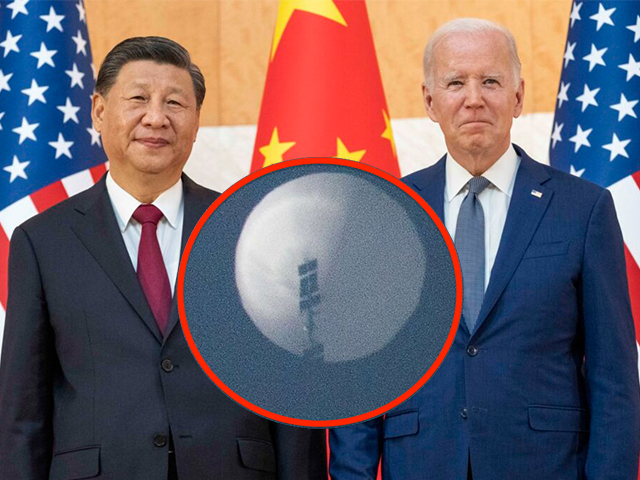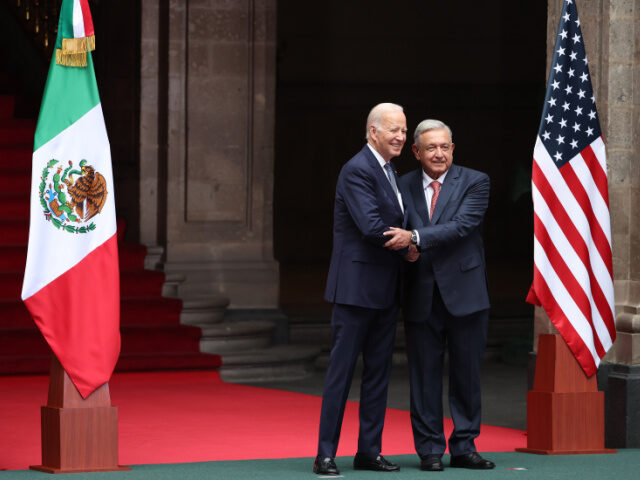Senior economist Luis Torres of the Federal Reserve Bank of Dallas noted on Tuesday that Mexico has replaced China as the top U.S. trading partner, racking up $263 billion in trade during the first four months of 2023. China had been the top American trading partner since 2014, when it displaced Canada.
Torres said Mexico’s rise to the top spot was driven by “fractious U.S. relations with China,” U.S. tariffs imposed on Chinese goods in 2018, and “pandemic-era supply-chain disruptions that altered international trade and investment flows worldwide.”

U.S. President Joe Biden, right, stands with Chinese President Xi Jinping before a meeting on the sidelines of the G20 summit meeting, Monday, Nov. 14, 2022, in Bali, Indonesia (AP Photo/Alex Brandon; Screenshot).
Manufactured goods were a key element of Mexico’s growing trade with the United States, accounting for $234.2 billion of the $263 billion volume for the first four months of 2023. Trade with Mexico now covers 15.4 percent of all U.S. imports and exports.
Canada is actually back in second place, according to Torres, with 15.2 percent of U.S. imports and exports, followed by China with 12 percent.
Torres explained that China’s trade with the United States exploded after China joined the World Trade Organization (WTO) in 2001. What followed was not entirely good news for American consumers, and especially not for American workers:
Once in the WTO, China’s access to the world’s premier consumer markets, combined with its own economic prowess and ability to marshal resources for growth, quickly transformed the country into a leading manufacturing hub.
Within a decade of its admission, critics increasingly accused China of flooding the world with cheap exports while limiting foreign access to its market. China’s trade growth coincided with sharp declines in U.S. manufacturing employment. Sectors and regions especially exposed to China’s trade tended to experience higher unemployment, lower labor force participation and reduced wage growth.
Mexico took up the slack after the U.S.-China trade war began in 2018, and has also benefited from the push for “nearshoring,” or moving manufacturing operations out of China into closer (and less politically hostile) countries.
Besides pulling supply chains away from the iron fist of the crackdown- and lockdown-prone Chinese Communist Party, nearshoring reduces shipping costs and makes it easier to coordinate with factories in the same time zone. Actually moving manufacturing back into the United States is out of the question because of sky-high labor costs, real estate prices, and regulatory burdens, so Mexico has become the nearshoring darling of the Americas.
Torres highlighted the importance of the “maquiladoras,” foreign-run factories that take advantage of cheap Mexican labor for manpower-intensive manufacturing processes. The U.S. automotive industry has long sent massive shipments of parts down to Mexico, where cars are built and returned across the border for sale in the United States.
Computer and electronic equipment are catching up to vehicle manufacturing in maquiladoras factories, thanks to the push for nearshoring, and a few other industries are shifting more of their operations to Mexico, although Torres cautioned that Mexico’s manufacturing remains more expensive than China’s, resulting in higher retail prices and/or lower profit margins for U.S. companies.
China keeps labor costs down by using forced labor from captive populations, such as the Uyghur Muslims, and workers lucky enough to get paid typically receive very low wages by free world standards.

A protester from the Uyghur community living in Turkey, holds an anti-China placard during a protest in Istanbul, Thursday, March 25 (AP Photo/Emrah Gurel).
“While the principal focus of trade policy was once free trade, greater efficiency and lower prices, that may no longer be the case. Today’s global economic relationships encompass a myriad of concerns, among them national security, climate policy and supply-chain resiliency,” Torres concluded.
Business Insider (BI) added to Torres’s analysis by suggesting the pandemic taught American consumers to expect very rapid delivery times, making nearshoring and shipping networks that do not have to cross the Pacific Ocean more attractive – a factor BI dubbed the “Amazon Prime Effect.”
Regional supply chains also have the beneficial side effect of creating more jobs in the United States, even if the manufacturing is done in other hemispheric nations. For example, analysts say about 40 percent of the parts sent to Mexican factories are made in the United States, while the same can be said for only four percent of the parts used in Chinese factories.
BI more somberly noted that some big retailers, such as Walmart, are growing nervous that deteriorating relations with China could abruptly cut off supply chains, so “regionalization” looks safer than “globalization” these days, even if it costs a bit more.

Walmart associate Luis Gutierrez, center, checks out a customer at a Walmart Supercenter in Houston. The trade dispute between the U.S. and China is weighing on the retail sector (AP Photo/David J. Phillip, File).
Another BI piece asserted that the costs of shifting manufacturing from China to Mexico should not be underestimated. American consumers might balk at the higher retail prices paid for goods made with cheap Mexican labor instead of incredibly cheap Chinese labor since the average consumer does not spend as much time worrying about fragile transoceanic supply lines and grim Chinese Communist overlords ordering factory shutdowns as professional market strategists do.

COMMENTS
Please let us know if you're having issues with commenting.